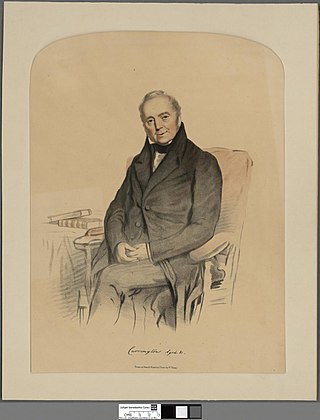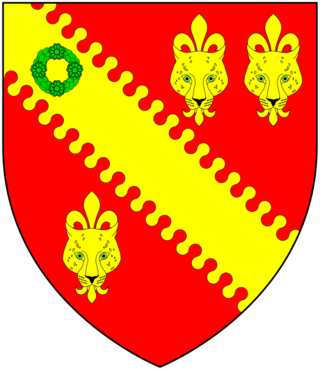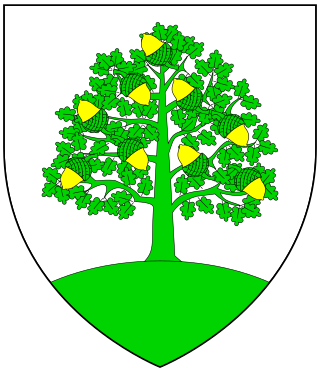
Marquess of Bath is a title in the Peerage of Great Britain. It was created in 1789 for Thomas Thynne, 3rd Viscount Weymouth. The Marquess holds the subsidiary titles Baron Thynne, of Warminster in the County of Wiltshire, and Viscount Weymouth, both created in 1682 in the Peerage of England. He is also a baronet in the Baronetage of England.

Earl of Cardigan is a title in the Peerage of England that was created by Charles II in 1661 for Thomas Brudenell, 1st Baron Brudenell, and the title has been held since 1868 by the Marquesses of Ailesbury. Since that time, it has been used as a courtesy title by the heir apparent to that Marquessate, currently Thomas Brudenell-Bruce, Earl of Cardigan, only son of the 9th Marquess.

Earl of Buckinghamshire is a title in the Peerage of Great Britain. It was created in 1746 for John Hobart, 1st Baron Hobart.

Viscount Gage, of Castle Island in the County of Kerry of the Kingdom of Ireland, is a title in the Peerage of Ireland. It was created in 1720 for Thomas Gage, along with the subsidiary title of Baron Gage, of Castlebar in the County of Mayo, also in the Peerage of Ireland. In 1744 he also succeeded his cousin as eighth Baronet, of Firle Place. The titles remain united. The Gage family descends from John Gage, who was created a baronet, of Firle Place in the County of Sussex, in the Baronetage of England on 26 March 1622. His great-grandson, the seventh Baronet, represented Seaford in Parliament. He was succeeded by his first cousin, Thomas Gage, 1st Viscount Gage, the eighth Baronet. He sat as a Member of Parliament for Minehead and Tewkesbury and also served as Governor of Barbados. In 1720, 24 years before succeeding in the baronetcy, he was raised to the Peerage of Ireland as Baron Gage and Viscount Gage. His second son was the military commander the Hon. Thomas Gage.

Baron Carrington is a title that has been created three times, once in the Peerage of England, once in the Peerage of Ireland and once in the Peerage of Great Britain.

Baron Inchiquin is one of the older titles in the Peerage of Ireland. It was one of two titles created on 1 July 1543 for Murrough O'Brien, Prince of Thomond, who claimed descent from Brian Boru, a High King of Ireland. The English titles were granted under the policy of surrender and regrant, and therefore conditional upon the abandonment of any Irish titles, the adoption of English customs and laws, pledging of allegiance to the Crown, apostasy from the Catholic Church, and conversion to the Church of Ireland. Murrough was made both Earl of Thomond in the Peerage of Ireland, with remainder to his nephew Donough O'Brien and Baron Inchiquin, with remainder to his male heirs. Following the death of his cousin, Conor Myles John O' Brien in June 2023, Conor John Anthony O' Brien is currently the 19th Baron Inchiquin
Baron Ravensworth, of Ravensworth Castle in the County Palatine of Durham and of Eslington Park in the County of Northumberland, is a title in the Peerage of the United Kingdom.

Baron Ashburton, of Ashburton in the County of Devon, is a title that has been created twice, once in the Peerage of Great Britain and once in the Peerage of the United Kingdom. Since 1835, the title has been held by members of the Baring family.

Baron Denman, of Dovedale in the County of Derby, is a title in the Peerage of the United Kingdom. It was created in 1834 for the prominent lawyer, judge and Whig politician Thomas Denman. He served as Lord Chief Justice of the King's Bench from 1832 to 1850. His son, the second Baron, assumed in 1876 by royal licence the additional surname of Aitchison, which was that of his father-in-law. He was succeeded by his grandnephew, the third Baron. He was the grandson of the Hon. Richard Denman, younger son of the first Baron. Lord Denman notably served as Governor-General of Australia from 1911 to 1914. He was succeeded by his eldest son, the fourth Baron. On his death in 1971, the title passed to his first cousin, Sir Charles Denman, 2nd Baronet, of Staffield, who became the fifth holder of the title.

Baron Moncreiff, of Tulliebole in the County of Kinross, is a title in the Peerage of the United Kingdom. It was created on 9 January 1874 for the lawyer and Liberal politician Sir James Moncreiff, 1st Baronet. He had already been created a Baronet, of Kilduff in the County of Kinross, in the Baronetage of the United Kingdom on 23 May 1871. In 1883 Lord Moncreiff also succeeded his elder brother as 11th Baronet, of Moncreiff in the County of Perth. On his death the titles passed to his eldest son, the second Baron. He was a Judge of the Court of Session from 1888 to 1905 under the title of Lord Wellwood and served as Lord Lieutenant of Kinross-shire between 1901 and 1909. He was succeeded by his younger brother, the third Baron. He was a clergyman. As of 2010 the titles are held by the latter's great-grandson, the sixth Baron, who succeeded his father in 2002.

Baron Tennyson, of Aldworth in the County of Sussex and of Freshwater in the Isle of Wight, is a title in the Peerage of the United Kingdom. It was created in 1884 for the poet Alfred Tennyson. His son, the second Baron, served as Governor-General of Australia, and his grandson, the third Baron, as a captain for the English cricket team. On the death in 2006 of the latter's younger son, the fifth Baron, the line of the eldest son of the first Baron failed. The title was inherited by the late Baron's second cousin once removed, the sixth and present holder of the peerage. He is the great-grandson of Hon. Lionel Tennyson, second son of the first Baron.
There have been two baronetcies created for a person with the surname Clifford.
There have been two baronetcies created for persons with the surname Colquhoun ("Cohoon"), one in the Baronetage of Nova Scotia (1625) and one in the Baronetage of Great Britain (1786).

Viscount Bulkeley, of Cashel in the County of Tipperary, was a title in the Peerage of Ireland. It was created on 19 January 1644 for Thomas Bulkeley, the son of Sir Richard Bulkeley of Beaumaris and a supporter of King Charles I of England. The title descended from father to son until the death of his great-great-grandson, the 5th Viscount, in 1738. The late Viscount was childless and was succeeded by his younger brother, the 6th Viscount. The latter was succeeded by his son, the 7th Viscount. The 7th Viscount was also created Baron Bulkeley, of Beaumaris, in the County of Anglesey, in the Peerage of Great Britain on 14 May 1784, which entitled him to a seat in the House of Lords. In 1802 he assumed by Royal licence the additional surname of Warren, which was that of his father-in-law, Sir George Warren. On his death in 1822 both titles became extinct. Sir Richard Williams, of Penrhyn, succeeded to the Bulkeley estates and assumed by Royal licence the additional surname of Bulkeley.

The Bunbury Baronetcy, of Bunbury, Oxon and Stanney Hall in the County of Chester, is a title in the Baronetage of England. It was created on 29 June 1681 for Thomas Bunbury, Sheriff of Cheshire from 1673 to 1674 and the member of an ancient Cheshire family. His grandson, Henry, the third Baronet, and great-grandson, the fourth Baronet, both sat as Members of Parliament for Chester. The latter died unmarried at an early age and was succeeded by his younger brother, the fifth Baronet. He was a clergyman. On his death in 1764 the title passed to his eldest son, the sixth Baronet. He represented Suffolk in the House of Commons for over forty years but is best remembered for his marriage to Lady Sarah Lennox. He died childless in 1821 and was succeeded by his nephew, the seventh Baronet. He was the son of Henry Bunbury, younger son of the fifth Baronet. The seventh Baronet was a distinguished soldier and politician. His eldest son, the eighth Baronet, was High Sheriff of Suffolk in 1868, and Fellow of the Royal Society. He died childless in 1886 and was succeeded by his younger brother, the ninth Baronet. He was Liberal Member of Parliament for Bury St Edmunds. He died unmarried in 1895 and was succeeded by his nephew, the tenth Baronet. He was the son of Colonel Henry William St Pierre Bunbury, third son of the seventh Baronet. He served as High Sheriff of Suffolk in 1908 and was a Deputy Lieutenant of the county. On his death in 1930 the title passed to his son, the eleventh Baronet. He was High Sheriff of Suffolk in 1936 and was a Deputy Lieutenant of the county. His son, the twelfth Baronet, was High Sheriff of Suffolk in 1972. As of 2014 the title was held by the latter's second but eldest surviving son, the thirteenth Baronet, who succeeded in 1985.

The Wood, later Page Wood Baronetcy, of Hatherley House in the County of Gloucester, is a title in the Baronetage of the United Kingdom. It was created on 16 December 1837 for Matthew Wood, Lord Mayor of London from 1815 to 1817 and Whig Member of Parliament for the City of London from 1817 to 1843. The fifth Baronet assumed the additional surname of Page. Two other members of the family have also gained distinction. William Wood, 1st Baron Hatherley, Lord High Chancellor of Great Britain from 1868 to 1872, was the second son of the first Baronet while Field Marshal Sir Evelyn Wood was the fifth son of the second Baronet. Also, Katharine O'Shea, known for her relationship with Charles Stewart Parnell, was the daughter of the second Baronet. The theosophist and political activist Annie Besant, was the great-granddaughter of the 1st Baronet's father.
The Hort Baronetcy, of Castle Strange in the County of Middlesex, is a title in the Baronetage of Great Britain. It was created on 8 September 1767 for John Hort, Consul-General at Lisbon, Portugal. He was the second son of The Right Reverend Josiah Hort, Archbishop of Tuam. The second Baronet sat as Member of Parliament for Kildare from 1831 to 1832. The third Baronet was a Lieutenant-General in the British Army and fought in the Crimean War. The current Baronet is Sir Andrew Edwin Fenton Hort, of East Prawle, Devon.

The Wake Baronetcy, of Clevedon in the County of Somerset, is a title in the Baronetage of England. It was created on 5 December 1621 for Baldwin Wake. The sixth Baronet assumed the additional surname of Jones but died childless. The eighth Baronet sat as Member of Parliament for Bedford. The twelfth Baronet was High Sheriff of Northamptonshire in 1879. The thirteenth Baronet was a Major-General in the British Army. Another member of the family to gain distinction was Charles Wake, second son of the tenth Baronet; he was an Admiral in the Royal Navy.
There have been four baronetcies created for persons with the surname Hay, all in the Baronetage of Nova Scotia. Two creations are extinct, one dormant and one extant. A fifth baronetcy in the Jacobite Peerage, although theoretically extant, is not recognised by the Lyon Office.

Sir John Dermot Turing, 12th Baronet is a British solicitor and author.













